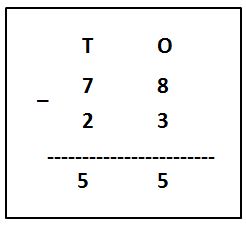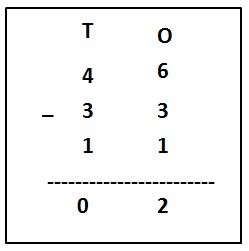Subtracting 2-Digit Numbers is the subtraction of one number from another number. Subtraction of Numbers is not that easy as the addition. There are certain rules included while subtracting numbers. Follow the entire article to learn the Subtraction of 2-Digit Numbers. Know the Step by Step Procedure on How to Subtract 2 Digit Numbers with and without Regrouping or Borrowing. It becomes easy to solve all 2-Digit Numbers Subtraction after you solve every problem present in this article.
Do Read:
- Subtracting 1-Digit Number
- Subtracting 3-Digit Numbers with Borrowing
- Find the Difference using Subtraction Property
How to Subtract Two-Digit Numbers?
Follow the below process to find the subtraction of the given two numbers. The step-by-step procedure will help you to find the answer without any confusion.
(i) Firstly, note down the given numbers.
(ii) Compare the given numbers and find the large number and small number.
(iii) Place the large number on the top and the small number below the large number.
(iv) Make sure you place the numbers as per the place value one below the other. Arrange the numbers vertically so that the ones’ place digits and tens’ place digits are lined up.
(v) Begin subtracting from one’s place digits column.
(vi) Subtract the numbers on one’s place digits column first then subtract the numbers on ten’s place digits column.
(vii) Note down the final answer.
Also, check:
Subtracting 2 Digit Numbers without Regrouping
Example 1.
Subtract 23 from 78.
Solution:
The given numbers are 23 and 78.

(i) Compare the given numbers. 78 is greater than 23.
(ii) Subtract one’s place digits. Subtract 3 from 8. 8 – 3 = 5. Place 5 in the one’s column as shown in the figure.
(iii) Subtract ten’s place digits. Subtract 2 from 7. 7 – 2 = 5. Place 5 in the ten’s column as shown in the figure.
(iv) Finally, the difference of 78 – 23 = 55.
The answer is 55.
Example 2.
Subtract 58 from 89.
Solution:
The given numbers are 58 and 89.

(i) Compare the given numbers. 89 is greater than 58.
(ii) Subtract one’s place digits. Subtract 8 from 9. 9 – 8 = 1. Place 1 in the one’s column as shown in the figure.
(iii) Subtract ten’s place digits. Subtract 5 from 8. 8 – 5 = 3. Place 3 in the ten’s column as shown in the figure.
(iv) Finally, the difference of 89 – 58 = 31.
The answer is 31.
Example 3.
Subtract 25 from 57.
Solution:
The given numbers are 25 and 57.

(i) Compare the given numbers. 57 is greater than 25.
(ii) Subtract one’s place digits. Subtract 5 from 7. 7 – 5 = 2. Place 2 in the one’s column as shown in the figure.
(iii) Subtract ten’s place digits. Subtract 2 from 5. 5 – 2 = 3. Place 3 in the ten’s column as shown in the figure.
(iv) Finally, the difference of 57 – 25 = 32.
The answer is 32.
Subtracting 2 Digit Numbers with Regrouping
Subtraction of 2-Digit Numbers is possible with the Regrouping when the minuend digit is less than the subtrahend digit. The regrouping allows you to borrow a number from ten’s digit and make your subtraction simple.
How to Subtract 2-Digit Numbers with Regrouping?
Follow the below steps to find the Subtraction of 2-Digit Numbers with the regrouping or borrowing. The below process will help you to find the final answers while subtracting.
(i) Note down the given numbers.
(ii) Compare the numbers and find the large number and small number.
(iii) Place the large number on the top and the small number below the large number.
(iv) Start your subtraction from one’s place digits column.
(v) If the minuend digit is less than the subtrahend digit, then regroup the number by taking the value from tens place.
(vi) Then subtract the one’s place digits column and note down the number.
(vii) Reduce one number in ten’s place digit and perform the subtraction operation.
(viii) Finally, note down the answer.
2-Digit Numbers with Regrouping Examples
Example 1.
Subtract 26 from 54.
Solution:
The given numbers are 26 and 54.

(i) Compare the given numbers. 54 is greater than 26.
(ii) Subtract one’s place digits. Subtract 6 from 4. 4 is smaller than 6. Therefore, borrow 10 from ten’s place digit. Now 4 becomes 14.
(iii) Subtract 6 from 14. 14 – 6 = 8.
(iv) Reduce the number 5 to one digit i.e, 4.
(v) Now, subtract ten’s place digits. Subtract 2 from 4. 4 – 2 = 2. Place 2 in the ten’s column as shown in the figure.
(vi) Finally, the difference of 54 – 26 = 28.
Example 2.
Subtract 38 from 72.
Solution:
The given numbers are 38 and 72.

(i) Compare the given numbers. 72 is greater than 38.
(ii) Subtract one’s place digits. Subtract 8 from 2. 2 is smaller than 8. Therefore, borrow 10 from ten’s place digit. Now 2 becomes 12.
(iii) Subtract 8 from 12. 12 – 8 = 4.
(iv) Reduce the number 7 to one digit i.e, 6.
(v) Now, subtract ten’s place digits. Subtract 3 from 6. 6 – 3 = 3. Place 3 in the ten’s column as shown in the figure.
(vi) Finally, the difference of 72 – 38 = 34.
Example 3.
Subtract 73 from 81.
Solution:
The given numbers are 73 and 81.

(i) Compare the given numbers. 81 is greater than 73.
(ii) Subtract one’s place digits. Subtract 3 from 1. 1 is smaller than 3. Therefore, borrow 10 from ten’s place digit. Now 1 becomes 11.
(iii) Subtract 3 from 11. 11 – 3 = 8.
(iv) Reduce the number 8 to one digit i.e, 7.
(v) Now, subtract ten’s place digits. Subtract 7 from 7. 7 – 7 = 0. Place 0 in the ten’s column as shown in the figure.
(vi) Finally, the difference of 81 – 73 = 8.
Subtracting Three Numbers of 2-Digits
You can also subtract the three numbers of 2-digits easily by following the procedure. The subtraction of three numbers of 2-digits is similar to the two numbers of 2-digits. Check out the below examples to understand the subtraction of three numbers of 2-digits.
Example 1.
Subtract 15, 96, and 61.
Solution:
The given numbers are 15, 96, and 65.

(i) Compare the given numbers. Place them vertically from largest number to small number. 96, 61, and 15.
(ii) Subtract one’s place digits. 6 – 1 – 5 = 0. Place 0 in the one’s column as shown in the figure.
(iii) Subtract ten’s place digits. 9 – 6 – 1 = 5. Place 2 in the ten’s column as shown in the figure.
(iv) Finally, the difference of 96 – 61 – 15 = 20.
The answer is 20.
Example 2.
Subtract 87, 32, and 43.
Solution:
The given numbers are 87, 43, and 32.

(i) Compare the given numbers. Place them vertically from largest number to small number. 87, 32, and 43.
(ii) Subtract one’s place digits. 7 – 3 – 2 = 2. Place 2 in the one’s column as shown in the figure.
(iii) Subtract ten’s place digits. 8 – 4 – 3 = 1. Place 1 in the ten’s column as shown in the figure.
(iv) Finally, the difference of 87 – 43 – 32 = 12.
The answer is 12.
Example 3.
Subtract 46, 33, and 11.
Solution:
The given numbers are 46, 33, and 11.

(i) Compare the given numbers. Place them vertically from largest number to small number. 46, 33, and 11.
(ii) Subtract one’s place digits. 6 – 3 – 1 = 2. Place 2 in the one’s column as shown in the figure.
(iii) Subtract ten’s place digits. 4 – 3 – 1 = 0. Place 0 in the ten’s column as shown in the figure.
(iv) Finally, the difference of 46 – 33 – 11 = 2.
The answer is 2.
Note: The number from which a smaller number is subtracted is called minuend.
The number to be subtracted is called the subtrahend.
The number which is then subtracted result is called the difference.
